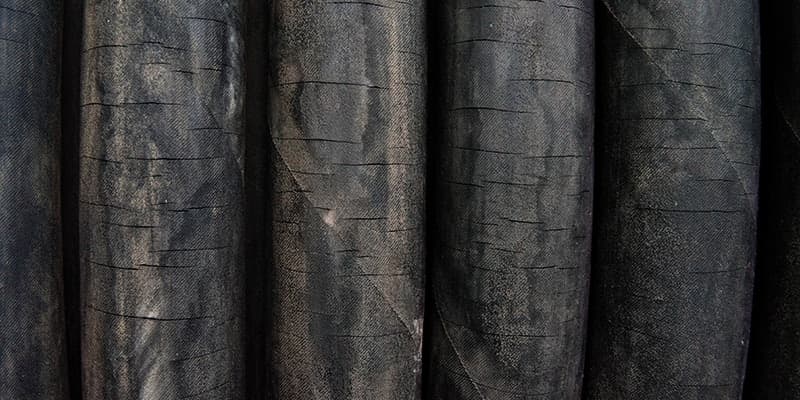
Wintertime and extreme low temperatures can pose a challenge to rubber hydraulic hoses. If your hydraulic system is not properly equipped to perform when temperatures drop, you will notice a negative impact on its performance and efficiency. Armed with the right hydraulic hose and protective accessories, you can avoid damage to your hose and potential hydraulic system failure.
Are hydraulic hoses made to withstand freezing temperatures?
Industry standard hydraulic hoses are made to withstand a temperature range from –40°F to 212°F. For freezing applications (– 40°F to – 70°F), opt for a low temp hydraulic hose. Low temp hoses are designed to support hydraulic systems facing extremely cold temps—such as harsh winters in regions like the upper Midwest or the Rockies, or in environmentally-controlled deep freeze storage applications. Low temperature hydraulic hoses are specifically engineered for extreme cold environments, withstanding temperatures all the way down to –70°F.
How to protect hydraulic hoses from freezing in the winter

Given the porous nature of synthetic rubber, it’s best to avoid exposing your hydraulic hose to freezing, melting, and refreezing. This can cause your hose to become stiff, brittle, and even crack. So, be sure to choose a hydraulic hose that is engineered for such extreme temperature changes whether that be for low temp hydraulic fluid inside the hose or exposure to snow or ice externally. Once the cover of the hose is damaged the rate of failure doubles.
As an added measure for protecting the outside of the hose, some hydraulic equipment operators will use an external cover or hose protection sleeve to help protect the hose itself from exposure to freezing, melting, and refreezing water on the outside of the system.
Extreme low temperatures can also affect hydraulic fittings and accessories such as O-Rings used for coupling connections. If you plan to temporarily pause use of your hydraulic system in the winter, be sure to drain the hydraulic hose liquid and store the hose in a dry place away from the elements.
How to extend the longevity of your hydraulic hose

One of the most important factors in extending the life of your hydraulic hose and accessories is routine preventative maintenance of the entire hydraulic system. Operators working the hydraulic system should conduct routine visual inspections a minimum of once per quarter, looking closely for any cracking or cover bubbling in the hose.
It’s important to note that most equipment is not rigged with low temp hosing. As a preventative and time-saving measure, replacing standard hydraulic hoses with low temp hoses can help extend your equipment’s longevity and avoid costly unplanned downtime.
How long will a hydraulic hose last in cold weather?
Exposure to the elements or improper use or maintenance of your hydraulic system can compromise the integrity of a hydraulic hose. However, standard and extreme temperature hydraulic hoses are engineered to last a very long time, in many cases several years with the right care and maintenance. When the proper hose is chosen for a low temp application, there’s no reason your hose won’t last for a long time to come.
How to properly store hydraulic hoses against the elements
It’s best practice to purchase extra parts and accessories to have on file for routine, preventative maintenance or for a quick repair when equipment goes down unexpectedly. If your hydraulic system is exposed to extremely cold temperatures, be sure to keep the appropriate cold-temp hydraulic hose and accessories in stock in a climate-controlled environment, away from the elements. Hang your hoses or stack them on shelving up off the floor where water or fluid cannot accumulate in the event of a spill or flood.
What hydraulic applications require low temp hoses?
There are a variety of commercial and industrial applications that may require a low temp hydraulic hose. Your hydraulic system may be exposed to outside elements such as in construction or in a forestry application or you may have an internal operation such as in food and beverage. The following applications have instances requiring low temp hoses:
- Food and beverage
- Pharmaceuticals
- Construction
- Oil and gas
- Surface mining
- Forestry
- Waste handling
How are hydraulic hoses tested for extreme low temperatures?
In order to perform in extreme cold weather, hydraulic hose manufacturers conduct rigorous testing to ensure their low temp hoses meet application requirements. Take for instance, hose manufacturer, Continental. To achieve optimal performance in extreme low temperatures, the Artic hose rubber compound was changed from type c nitrile to chlorinated polyethylene (CPE) rubber. The CPE hose was frozen down to –70 degrees and placed in a cooler for 24 hours. It then went through a cold bend radius test. The hose maintained its flexibility and did not crack, proving it to be ideal for routing, installing, and operating in extreme low temperatures.
Shop hydraulic hoses & accessories
Need help choosing the right hydraulic hose?
We’re experts in hydraulics. Talk to one of our trusted tech service or sales reps today for help choosing the right products for your hydraulics application. Contact us or call 800-669-9650 to speak with a member of our Customer Service team at any of our 11 locations (Knoxville, TN; Marietta, GA; Orlando, FL; Charlotte, NC; Little Rock, AR; Fort Worth, TX; Benton, IL; Madisonville, KY; Princeton, WV; Birmingham, AL; Calvert City, KY).
